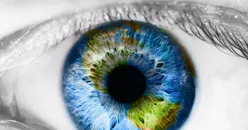
Dry Eye Syndrome and Treatments
What is Dry Eye Syndrome?
Dry Eye Syndrome, also known as dry eye, is a condition that occurs when there is a lack of tears on the cornea, which is the clear front part of your eye. Tears are produced by special glands in your eyes, and when you blink regularly, the tears cover the cornea. Without tears, the cornea can dry out, leading to significant damage and intense pain. There can be several factors responsible for the lack of tears, but in this blog, we’ll be discussing what you can do to relieve the symptoms.
Eye pain can refer to various uncomfortable sensations in your eyes, such as a gritty feeling, burning, dryness, or scratchiness. These are all symptoms of dry eye, and if they persist, you should consult your eye doctor, whether an ophthalmologist or optometrist. It’s because other serious eye disorders may have similar symptoms to dry eye, and if it’s severe, persistent, and painful, it’s best to see a doctor.
What Causes Dry Eye?
Dry eye occurs when the eyes do not produce enough tears or when the tears evaporate too quickly. Tears play a vital role in eye health, providing lubrication and cleansing to the cornea, maintaining its clarity, and protecting against infections. Several factors can cause dry eye, including environmental factors such as dry air or smoke, prolonged screen time which reduces regular blinking, aging, some medications, and extended contact lens use. In addition, some medical conditions can lead to or cause dry eye, including immune dysfunction and other metabolic disorders. It is critical to see a doctor if you have dry eye pain that doesn’t go away. Both men and women can develop dry eyes, and as you get older, the chances increase.
Dry Eye Diagnosis
If you want to see an eye doctor to figure out if you have dry eye or some other eye problem, this is easy to do. Schedule an appointment with an eye doctor (ophthalmologist or optometrist) for a check-up. The doctor will do several tests to determine if you have dry eye, what might be causing the problem, and what kind of therapies might help. In addition, the eye exam may reveal other eye disorders that are similar to dry eye, and lead to the best treatment.
Risk Factors, Prevention, and Treatment Options
To prevent or alleviate dry eye symptoms, various non-medical approaches may be effective. One simple method is to use a humidifier in your environment to increase moisture levels in the air. Wear sunglasses to protect your eyes from sun, wind, smoke, and dust. Taking breaks during prolonged screen use to blink more frequently and using artificial tear drops can also help keep the eyes lubricated. Additionally, staying hydrated, consuming foods rich in omega-3 fatty acids like fish, and using vitamin supplements specially formulated for eye health can help alleviate dryness. It’s essential to maintain good eye hygiene, avoid rubbing your eyes, and consult with an eye doctor for personalized recommendations and treatment options if dry eye symptoms persist.
Here are some simple suggestions and procedures you can do at home to improve eye health and prevent or reduce dry eye syndrome discomfort:
- Screen Time: Prevent tear evaporation by taking breaks away from screen use on computers, TVs, and smartphones.
- Blinking: Remind yourself to blink regularly, especially during screen time.
- Eye Drops: Use over-the-counter eye drops to help lubricate the eyes and alleviate dryness.
- Hot Compress: Apply a clean, warm, damp washcloth to closed eyes daily to help unclog oil glands in the eyelids.
- Protection: Wear sunglasses to protect your eyes from sun, wind, smoke, and dust.
- Humidifier: Add moisture to the air with a humidifier to increase humidity levels, reducing dryness.
- Dietary assistance: Consume more omega-3 fatty acids found in foods such as fish or fresh vegetables.
- Vitamin supplements: Supplements recommended for eye health can be found at many locations.
- Soothe eyes: Wash your hands with warm to hot water, dry them with a clean cloth and place your hands over your eyes for a minute.
- Medical Help: If your symptoms don’t go away go to your eye doctor or an emergency clinic.
Here are some more details about the above recommendations:
- Hot Compress. You can help dry eye symptoms a lot by doing this daily. Take a clean washcloth, and run hot tap water onto the cloth until very wet and hot. It should be so hot that your fingers can barely stand it. Then fold into quarters, and then half again, lean over the sink, and press the folded cloth onto your eyes, both eyes at the same time. Hold for at least one minute, then refold the cloth and hold onto the eyes for another minute. Your eyes should be very warm at this point. Then unfold the washcloth and rub gently onto the eyes, back and forth along the eyelid margins, for about a minute. Doing this daily should help unclog the tiny oil glands in the eyelid margin (Meibomian glands) which will refresh the tear film health.
- Blink Reflex. Many of us spend a lot of time on our computers, phones, or tablets. During this screen time, we tend to focus on the screen so much that we forget to blink. Blinking is a very important reflex as it distributes the tears evenly over the clear surface of the eye, the cornea. Without constant blinking, the surface of the cornea can dry out, and this can eventually lead to dry eye syndrome. So, when on a screen, try to blink every 10 – 15 seconds. There are numerous blink reminder apps available online that can be downloaded that click or tick to remind you to blink regularly.
- As mentioned above, use a humidifier in your environment, take breaks, blink regularly during prolonged screen use, and use artificial tear drops to keep the eyes lubricated. Protect your eyes from wind and smoke, wear dark glasses outside, avoid rubbing your eyes, stay hydrated, eat a healthy diet, and take vitamin supplements specially formulated for eye health.
- If these daily recommendations still aren’t helping, you should see an eye doctor. Some treatment options eye doctors may recommend include prescription eye drops if he or she feel that you need more therapeutic potential for your symptoms.
How Eye Care Emporium Helps with Eye Care
At the Eye Care Emporium, we work hard to help you maintain and protect your eyesight. With our monthly blog articles on eye care, we introduce and review common-sense and topical information on eye care in general, In our monthly newsletter (sign up below) we will discuss breaking news in eye science and medical innovations. Click below to sign up for our monthly newsletter and access to blogs, news, and updates on eye care methods.
These blogs at Eye Care Emporium will continue with short segments on eye health and common sense home eye care.
Eye Care Emporium will continue to provide eye care advice, education and support such as this. Also, this is an Emporium so we will be providing research and advisories on products that are available that assist in eye care health. To continue to receive our blogs and updates on eye care, click the Subscribe button below. We will soon publish an extensive review of Dry Eye Syndrome to completely cover the thumbnail sketches above. Subscribe below to get this update. We’re dedicated to helping you achieve and maintain optimal eye health and vision.
